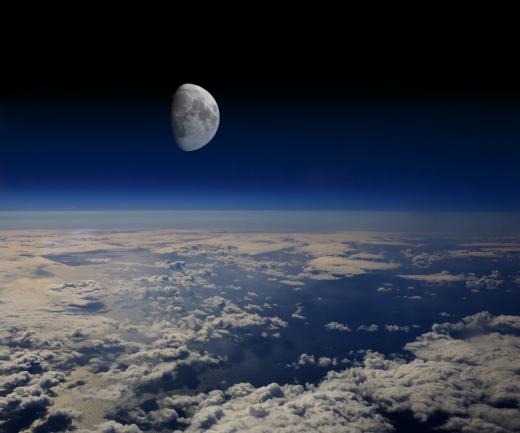What is a Perigee?
 Mary McMahon
Mary McMahon
When an object orbiting the Earth is at the closest point to the Earth in its orbit, this stage is referred to as perigee. By contrast, when the same object is the furthest it can possibly be in in its orbit, it is said to be in “apogee.” This term was first used in reference to the moon, which regularly moves through perigee and apogee as it orbits the Earth, although it can also be applied to the numerous man-made satellites which orbit the Earth.
Orbits are elliptical, rather than circular, which explains why satellites can be at varying distances in relation to Earth as they orbit. More generally, astronomers use the term “apsis” to encompass both the closest and furthest points in an orbit, with periapsis being the closest, and apoapsis being the furthest. When talking about things which orbit the Earth specifically, astronomers refer to apogee and perigee, and there are specialized terms for objects which orbit other major celestial bodies as well, such as objects which move around the sun (perihelion and aphelion).

The moon's varying distance from Earth plays a role in the weather and in tides. When the moon is at perigee, it exerts more force on the Earth, which can cause tides to be more extreme. Weather cycles can also vary cyclically with the moon's orbit, and as a result, weather and tide forecasters rely on astronomical projections about the moon's distance when they prepare forecasts and reports. At any given time, astronomers can calculate how far the moon is from Earth, and how many days it will take for the moon to reach perigee.

Occasionally, people look at the moon and notice that it seems to be bigger than usual, which doesn't seem possible. The answer to this mystery lies in the fact that when the moon is in perigee, it really does appear slightly larger than when it is in apogee, because it is closer. People who are interested in running a little experiment can take a photograph of the full moon when the moon is in apogee, and repeat the conditions when the full moon is next in perigee to see an illustration of the size difference.

Being able to calculate apogee and perigee is also important for companies which launch and maintain satellites. It is important for an object to find the right orbit so that it will remain orbiting without being pulled to Earth, and perigee can represent a danger point in the orbit of a satellite if it is too close to Earth.
AS FEATURED ON:
AS FEATURED ON:













Discuss this Article
Post your comments